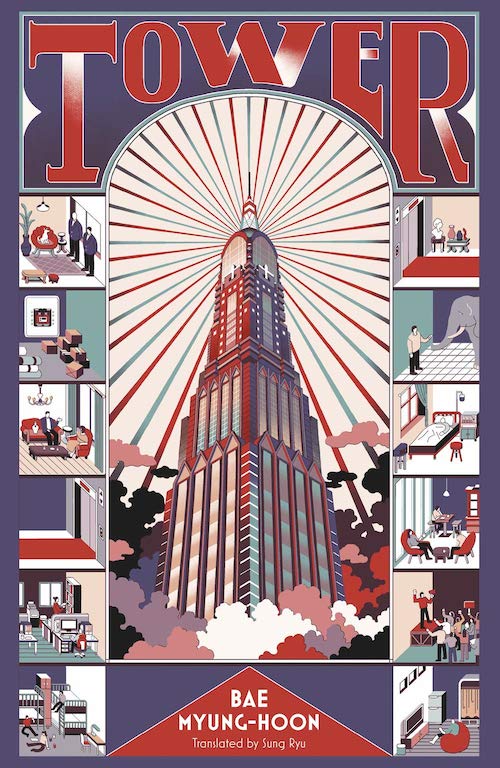
Bae Myung-hoon’s Tower (타워) comprises six interlinked stories, which take place almost entirely within a single building inhabited by 500,000 people. To that setting I imagine Western readers reacting with the look of the stunned distaste I sometimes receive when, back in the United States, I describe the standard form of middle-class housing in Seoul: clusters of 10, 20, 30 buildings, rising to 20, 30, 40 stories each. That verticality alone signals dystopia to many Americans, but to no few English as well — most notably J.G. Ballard, whose 1975 novel High-Risedramatizes the swift and total breakdown of society that occurs in, and is seemingly caused by, a luxury apartment complex of the titular form. No such fate befalls Beanstalk, the 674-story tower imagined by Bae, though it does experience a few close calls, subject as it seemingly is to constant threat from within and without.
Beanstalk isn’t just a building but a sovereign nation unto itself, locked in an ongoing Oceania-and-Eastasia-style geopolitical conflict with the distant country of Cosmomafia. This perhaps reflects the interests of the Seoul National University international-relations scholar Bae was when he began to build a readership as a writer of fiction. But in just over 250 pages, he also describes or alludes to aspects of Beanstalk and life within it in a range wide enough to reflect active fascinations with structural engineering, urban development, terrorism and antiterrorism, geographic information systems, literature, military strategy, Machiavellian politics, and Buddhism. The state of nirvana is invoked several times, once as a fighter pilot downed in a vast desert feels death’s approach (little knowing that the Beanstalkians have banded together to comb through satellite photos, facilitating his rescue), and again when an Indian elephant plunges from a 321st-story window.
The elephant is called Amitabh, a name borrowed (as Bae revealed in a recent podcast appearance) from Bollywood superstar Amitabh Bachchan. Show business bears more directly on the life a celebrity dog known as Film Actor P, another of Tower‘s non-human characters, who not only figures into several of its stories but turns up again in the last of its appendices to give an “interview.” You may at this point suspect the book of an unconventional structure, either by the standards of novels or those of short-story collections. Nor is it formally homogenous, with one epistolary story breaking up the omniscient third-person voice and two of the appendices constituting excerpts of texts referred to in the foregoing narratives: a sociological study of one of Beanstalk’s floors and a myth-like tale of a polar bear (who eventually does manage to attain nirvana) ostensibly by “Writer K,” star of the second story.
Read the whole thing at the Los Angeles Review of Books.